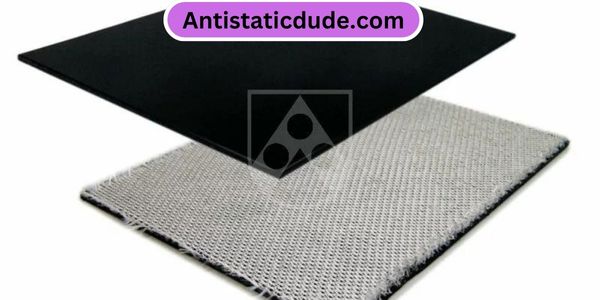Imagine your favorite wool sweater on a dry winter day, crackling with static electricity as you pull it over your head.
Antistatic materials act as superheroes, swooping in to save the day by preventing such shocking situations. From conductive polymers to metallic coatings, a plethora of options exist to combat static cling and electrical discharge.
But which material suits your needs best? Stay tuned to discover the ins and outs of these antistatic superheroes and how they can rescue you from hair-raising moments.

Conductive Polymers
When looking at antistatic materials, conductive polymers play a crucial role in dissipating electrical charges efficiently. These polymers are designed to conduct electricity, making them effective in preventing static buildup. They’re lightweight and flexible, allowing them to be easily integrated into various products like electronics, textiles, and packaging materials.
One significant advantage of conductive polymers is their ability to be tailored for specific applications. By adjusting the chemical composition and structure, the conductivity of these polymers can be finely tuned to meet the requirements of different industries. This versatility makes them a popular choice for manufacturers looking to enhance the antistatic properties of their products.
Additionally, conductive polymers offer a cost-effective solution compared to traditional metallic coatings. The manufacturing process is often simpler and more environmentally friendly, reducing production costs and waste. This makes conductive polymers a sustainable choice for companies aiming to improve their products’ performance while minimizing their environmental impact.
Metallic Coatings
Conductive polymers provide a versatile alternative to traditional metallic coatings for managing static electricity in various industries. However, metallic coatings remain a popular choice due to their effectiveness in dissipating static charges.
Here are four key points regarding metallic coatings:
- Conductivity: Metallic coatings offer high conductivity, allowing them to quickly discharge any accumulated static electricity.
- Durability: These coatings are known for their durability, providing long-lasting static dissipation solutions.
- Corrosion Resistance: Many metallic coatings are corrosion-resistant, making them suitable for use in challenging environments.
- Customizability: Metallic coatings can be tailored to meet specific requirements, offering flexibility in design and application.
When considering antistatic materials, metallic coatings play a significant role in preventing electrostatic discharge, particularly in industries where static electricity can pose risks to sensitive equipment or materials.
Carbon-Based Materials
Carbon-based materials offer a versatile solution for managing static electricity in various industries, providing an effective alternative to traditional antistatic methods. Carbon is known for its conductivity, making it a popular choice for antistatic applications. Carbon-based materials, such as carbon fibers, carbon black, and graphene, can be incorporated into different products like textiles, plastics, and flooring to dissipate static charges effectively. These materials work by providing a path for the static electricity to flow through, reducing the risk of damaging electrostatic discharge.
One of the key advantages of carbon-based materials is their durability and long-lasting effectiveness in controlling static electricity. They’re also lightweight and flexible, allowing for easy integration into various manufacturing processes without adding significant weight or bulk. Additionally, carbon-based materials are environmentally friendly compared to some traditional antistatic methods, making them a more sustainable choice for companies looking to reduce their carbon footprint. Overall, utilizing carbon-based materials for managing static electricity can improve product quality, increase safety, and enhance overall operational efficiency in diverse industries.
Ionizable Surfactants
Ionizable surfactants play a crucial role in managing static electricity by facilitating the dissipation of charges in various industrial applications. These surfactants contain both hydrophilic and hydrophobic parts, allowing them to interact with both water and non-polar substances.
Here are four key points to help you understand the importance of ionizable surfactants in controlling static electricity:
- Charge Dissipation: Ionizable surfactants can neutralize charges on surfaces, preventing the build-up of static electricity that can lead to damaging electrostatic discharge events.
- Enhanced Conductivity: By increasing the conductivity of materials, ionizable surfactants help to improve the flow of charges, reducing the likelihood of static buildup.
- Improved Antistatic Properties: Surfactants with ionizable groups can enhance the antistatic properties of materials, making them less prone to attracting or retaining static charges.
- Compatibility with Various Materials: These surfactants are versatile and can be used with a wide range of materials, making them valuable in diverse industrial settings where static control is essential.
Metal Oxides

Metal oxides serve as essential materials in the realm of static control due to their unique properties and versatile applications across various industries. One of the most commonly used metal oxides for static control is zinc oxide. Zinc oxide is known for its high conductivity, making it an effective antistatic agent in materials like rubber, plastics, and textiles.
Another metal oxide frequently employed for its antistatic properties is titanium dioxide. Titanium dioxide not only helps in reducing static buildup but also offers UV protection, making it ideal for applications in the cosmetics and sunscreen industries.
Metal oxides work by dissipating static charges, preventing the accumulation of electrical potential imbalances that can lead to damaging electrostatic discharge. By incorporating metal oxides into materials, manufacturers can enhance the safety and longevity of electronic components, textiles, and various products prone to static-related issues.
Whether it’s in the automotive, electronics, or packaging industry, the use of metal oxides as antistatic agents plays a crucial role in maintaining product quality and reliability.
Frequently Asked Questions
How Effective Are Antistatic Materials in Preventing Damage to Electronic Devices?
To prevent damage to electronic devices, antistatic materials are highly effective. They neutralize static electricity, reducing the risk of electrostatic discharge that can harm sensitive components. Using such materials is essential for protecting your devices.
Are There Any Environmental Concerns Associated With the Use of Antistatic Materials?
When using antistatic materials, be mindful of potential environmental concerns. Some antistatic agents can pose risks if not handled or disposed of properly. Consider eco-friendly alternatives to minimize the impact on the environment.
Can Antistatic Materials Be Easily Integrated Into Existing Manufacturing Processes?
You can seamlessly incorporate antistatic materials into your manufacturing processes. They offer a practical solution to prevent static electricity buildup, ensuring smoother operations. Integrate them easily for improved efficiency and product quality without major disruptions.
Are There Any Regulations or Standards That Govern the Use of Antistatic Materials in Products?
When using antistatic materials in products, regulations and standards govern their application. Ensuring compliance is crucial to meeting safety requirements and product quality standards. Following guidelines helps in producing reliable and effective antistatic products.
How Do the Costs of Using Antistatic Materials Compare to Other Methods of Preventing Static Electricity Buildup?
When comparing costs for preventing static electricity buildup, consider factors like maintenance, durability, and initial investment. Antistatic materials may require upfront expenses but can offer long-term savings by reducing risks and ensuring product quality.
Conclusion
In conclusion, there are various types of antistatic materials available, including:
- Conductive polymers
- Metallic coatings
- Carbon-based materials
- Ionizable surfactants
- Metal oxides
Each type has its own unique properties and applications for reducing static electricity. By understanding the different options and their benefits, you can choose the most suitable antistatic material for your specific needs.


Leave a Reply